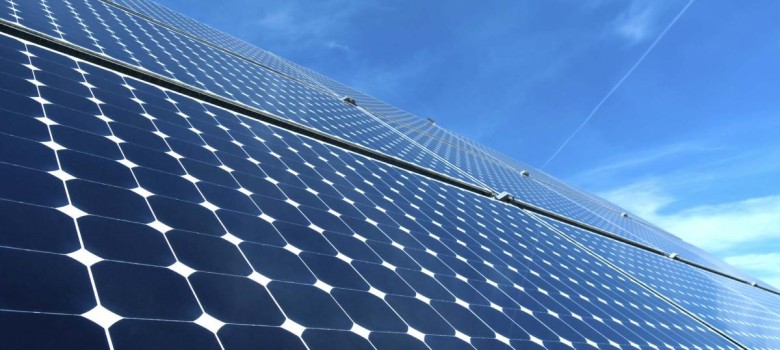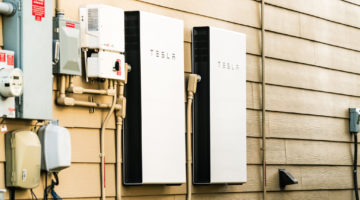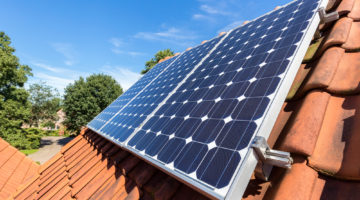
What is solar PV?
The process of converting light (photons) to electricity (voltage) is called the solar photovoltaic (PV) effect. Photovoltaic solar cells convert sunlight directly into solar power (electricity). They use thin layers of semi-conducting material that is charged differently between the top and bottom layers. The semi-conducting material can be encased between a sheet of glass and/or a polymer resin.
When exposed to daylight, electrons in the semi-conducting material absorb the photons, causing them to become highly energised. These move between the top and bottom surfaces of the semi-conducting material. This movement of electrons generates a current known as a direct current (DC). This is then fed through an inverter, which converts the power to alternating current (AC) for use in your home.
Types of solar panel
Different types of solar PV installations require slightly different components. However in the next two sections we have explained in detail all the main components that will make up your solar PV array and provide you with 100% renewable, free electricity.
The solar panel is the key component of any solar photovoltaic system, which takes the sun’s energy and converts it into an electrical current. There are three main types of solar panel (as well as the hybrid version) currently in commercial production, all of which are based on silicon semiconductors:
Monocrystalline solar cells
This type of solar cell is made from thin wafers of silicon cut from artificially-grown crystals. These cells are created from single crystals grown in isolation, making them the most expensive of the three varieties (approximately 35% more expensive than equivalent polycrystalline cells), but they have the highest efficiency rating – between 15-24%.
Polycrystalline solar cells
This type of solar cell is also made from thin wafers of silicon cut from artificially grown crystals, but instead of single crystals, these cells are made from multiple interlocking silicon crystals grown together. This makes them cheaper to produce, but their efficiency is lower than the monocrystalline solar cells, currently at 13-18%
Amorphous solar cells
These are the cheapest type of solar cell to produce, are relatively new to the market and are produced very differently to the two other types. Instead of using crystals, silicon is deposited very thinly on a backing substrate.
There are two real benefits of the amorphous solar cell; firstly the layer of silicon is so thin it allows the solar cells to be flexible, and secondly they are more efficient in low light levels (like during winter).
This, however, comes at a price; they have the lowest efficiency rating of all three types – approximately 7% – 9%, requiring approximately double the panel area to produce the same output. In addition, as this is a relatively new science, there is no agreed industry-wide production technique, so they are not as robust as the other two types.
Hybrid solar cells
This is not a type of solar cell in its own right; instead it is a combination of both amorphous solar cells and monocrystalline solar cells. These are known as HIT solar cells (Heterojunction with Intrinsic Thin Layer – a bit of a mouthful!), and have higher efficiency ratings than any of the other three types of solar cell alone. In addition, they are also better suited in sunnier climes, where temperatures often exceed 250C, creating up to 10% more electricity.
We think in many cases polycrystalline cells are the most suitable option, as they provide value for money while still also being relatively efficient.
Future solar technologies
- Research is currently underway to develop almost 100% transparent solar glass, which can be used in building applications. Organic polymer photovoltaics will be ultra-thin and more efficient than existing types, and could see windows transformed into electricity generators!
- Perovskite is a new type of solar cell which is more efficient than current types on the market. The technology is currently in refinement, as it has a number of flaws which would need to be resolved before it could be mass-produced.
Solar PV inverters
All the electricity produced by the solar panels is produced as direct current (DC), which differs from the electricity that is distributed through the grid and we use in our homes, which is alternating current (AC). For this reason most solar photovoltaic systems are now connected up with some type of inverter, which changes the DC to AC, allowing the individual to sell the electricity back to the grid (in grid-tied systems) or to be used easily in homes.
There are 2 major types of inverter that can be installed in your solar photovoltaic system:
1. String inverters (also known as central inverters)
These are used in grid-tied systems where the solar panels are wired together in series, which is known as a string of panels. Each string of panels is connected to a string inverter, which converts the DC current to AC for use in the home and selling back to the grid. You can imagine each string as a mini power station, producing electricity.
The main issue with string inverters is that if one of the panels in the string fails or produces less electricity (from things like shading), this impacts the output of all the panels. They will all operate at the output of the worst panel, so a small amount of shading or debris on your solar array can disproportionally reduce the total output of your entire solar photovoltaic system.
They also have relatively short lifespans when compared to micro inverters.
The benefits include simple wiring and that you can use thinner wires within your solar PV system, so less copper is used which makes the system cheaper. Buying one string inverter (which is normally the case of most home solar PV systems) is also considerably cheaper than buying multiple micro inverters.
2. Micro inverters
These are a newer technology and service each solar panel individually, so each panel requires its own micro inverter and acts as an individual power station. As a result, micro inverters do not suffer the same performance reduction as a result of shading because any power reduction in a particular solar panel is handled by one micro inverter, having little effect on the combined power output from the entire solar photovoltaic system.
Micro inverters are much more expensive than the string inverters. However much of this cost is offset by the increased performance (25% more power produced using micro inverters) and the fact that they are more reliable than string inverters (warranties for micro inverters are up to 25 years).
Buying inverters for your solar PV system
When looking for which inverters to buy, ideally you want your alternating current (AC) to match that provided by the utility companies. Waveform relates to the quality of the AC signal that an inverter produces. Cheaper inverters will provide modified sine wave signal, while the more expensive versions will produce the pure sine wave signal. Some appliances (such as computers) simply don’t work unless they are powered by a pure sine wave signal, so we recommend strongly that you spend a little more to get this type of inverter.
Grid tie inverters differ slightly from your regular inverters in that the AC pure sine wave signal has to be perfectly coordinated with the waveform from the grid. As such, these tend to be more expensive than the typical inverters that you buy. They also have a built-in safety feature to cut off power from the solar array if the electricity grid goes down for any reason.
It is also worth noting that most inverters now also have ‘Maximum Power Point Tracking’ (known as MPPT) installed within them, which helps to maximise the electrical output of your solar photovoltaic array system.
The principle of MPPT is to extract the maximum available power from the photovoltaic module by making them operate at the most efficient voltage (known as the maximum power point voltage). The algorithm included in the MPPT inverter compares the output from the photovoltaic module with grid voltage and then fixes it at the most efficient voltage, to allow you to export the maximum amount of kWh of electricity back to the grid. An MPPT charger in your solar photovoltaic system will improve your power gain by 20-45% in the winter and 10-15% in the summer.
Benefits
- All solar PV panels are rapidly decreasing in price due to better production techniques and increased competition between manufacturers and suppliers.
- Monocrystalline solar PV cells are the most efficient type of solar PV cell (rated between 15-24%), so smaller panels can produce equivalent amounts of electricity compared to other solar cell types.
- Polycrystalline solar PV cells are easier to produce than the monocrystalline solar PV cells and therefore cheaper to buy, still providing decent efficiency levels (13-18%).
- Amorphous solar PV cells are the easiest to produce and as the silicon is deposited on any surface, these panels can be made into any shape.
- Hybrid solar PV combine amorphous and monocrystalline cells giving you the advantages of both of these two types of solar cell.
Limitations
- Polycrystalline and amorphous solar PV cells are less efficient than monocrystalline, and therefore bigger panels are needed to produce the equivalent electricity output.
- The technique for building monocrystalline solar cells is more difficult and this is reflected in the higher price of this type of panel.
The battery
One of the major issues with solar PV systems is that they only produce electricity when the sun is shining. If you are looking to go ‘off-grid’ or have battery back up in times of grid blackouts, you will need batteries within your solar PV system.
In these systems, electricity produced from the solar cells is either used in the home as required, or if there is no demand in the home, it is converted to chemical energy in the form of batteries. These batteries can then produce the electicrity at night to allow you to use your solar PV system ’24/7′.
The electricity produced by your solar system is stored in deep-cycle lead acid batteries that look very similar to the ones found in most cars today (although structurally different). The two most popular types of battery are GEL and Absorbed Glass Mat (AGM), which store the charge very well and do not degrade nearly as fast as the common lead acid (wet cell) battery. Both types of batteries are designed to gradually discharge slowly and recharge 80% of their capacity a multiple number of times.
An automotive battery is a shallow-cycle battery, and this is designed to discharge only about 20% of its electricity so is unsuitable for solar photovoltaic set-up. The reason being is that if any more than 20% is drawn more than a few dozen times, it will get damaged and no longer take charge.
Solar photovoltaic batteries tend to operate at 12 volts, and can be arranged in banks (multiple batteries), increasing the storage potential of your solar photovoltaic set up. A bank of batteries organised in a series increases the capacity of your storage but also increases the voltage delivered from your bank, while multiple batteries organised in a parallel circuit increase the capacity, but keep the voltage the same (mains electricity runs at higher voltage, so if you have a grid tie system it is likely you will try to match this by running the batteries in series).
Solar Charge Controllers
Solar Charge Controllers (also known as Solar Charge Regulators) are used in solar photovoltaic systems to prevent the batteries from being overcharged. If you decide to implement a ‘grid-tied’ system, a solar charge controller is not necessary, as any excess electricity that you don’t use at any particular moment is sold directly back to the grid.
However, for any of the other three setups, a charge controller is necessary; it acts to regulate the flow of electricity between the solar photovoltaic modules, the batteries and your appliances (known as the load).
When the load is drawing power (e.g. you are watching television), the charge controller allows electricity to flow from the solar panels directly (if the sun is shining), or from the battery, or from a mixture of the two. The charge controller also prevents damage to the battery by monitoring the flow of electricity in and out. For instance if your system overcharges the battery, it will damage them. The same is also true if you completely discharge all the charge held within the battery.
At night, when the solar units are no longer producing electricity, the solar charge controller prevents reverse current flowing from the batteries back into the solar panels.
Solar charge controllers also are equipped with highly effective charging programs that maximise the charging speed, while still preventing overcharging.
Most are also equipped with maximum power point (MPPT) charging. The principle of MPPT is to extract the maximum available power from the photovoltaic module by making them operate at the most efficient voltage (known as the maximum power point voltage). The algorithm included in the MPPT solar charge controller compares the output from the photovoltaic module with the battery voltage and then fixes it at the best charging voltage, to get the maximum charge into the battery. The maximum power produced by the solar photovoltaic module is dependent on the amount of sun hitting the solar cells and the temperature of the cells. Incorporating a MPPT charger into your solar photovoltaic system will improve your power gain by 20-45% in the winter and 10-15% in the summer.
Solar array mounting
As discussed earlier, the amount of power that your solar photovoltaic system produces is dependent on the intensity of light hitting your solar array. There are three types of mounting you can get for your solar panels to help maximise the amount of light that they receive.
Fixed solar array mountings
These are the simplest of all the mounting systems, and also the cheapest. In this system, the solar panels will not move at all at any time during the year, so you want to ensure that when you put in the panels they are facing the equator to maximise sunlight.
Manually adjustable solar mountings
These can be changed a few times a year to adjust for the winter and summer sun. The sun is highest in the sky during the summer months and lower in the winter, so by being able to adjust the angle of your solar array ensures that the sunlight hits the array at the best angle to avoid reflection.
Fully automated tracking solar mount
These mountings track the sun, to ensure that at all times the angle of the solar array is maximising sunlight. These are certainly the most expensive type as they are constantly moving, but they are also by far the most efficient. Despite this, it has been proven to be more cost effective to add an extra solar panel to your array and use the fixed or adjustable mountings.
Installing Solar PV
Are you thinking about installing a solar PV system at home? We have scoured the country for the best tradespeople, so that we can make sure we only recommend those we really trust.
If you would like us to find you a local installer to help install a solar PV system in your home, just fill in the form below and we will be in touch shortly!












We have recently had solar panels installed at home and have a few questions for your team!
if there is a power cut- does our solar system still work (obviously if it is daytime) and provide us with the electricity? Therefore meaning our fridge-freezer would stay running??
yes it will keep running…….as far as there is power cut eithere during day or night time………at day time it can be supply current and at a same time charging
Hi Liz, unfortunately it doesn’t. We installed a grid tied system at your property – this means electricity can be sent back to the grid. It is a safety feature of this type of solar setup to prevent electricity to be sent back to the grid incase people are working on the line and get an unexpected shock!
Hi
I could not find the authors name for referencing sake and the year it was published or uploaded.please kindly give me this details thanks
Hi – if you can simply acknowledge to TheGreenAge – 2014.
I want to know about the nano-photovoltaic cells. I have read an article which give me information but still I am unable to understand it properly.
Hello, I will like to know the size of your solar panel that can power my 20KVA solar inverter.
Thanks for your anticipated prompt reply.
Please visit http://www.TheEcoStore.co.uk as they may be able to help. Thanks
Some advice as to the addition of battery storage useing lead crystal batteries and an inverter to an existing PV system would be appreciated ,do they justify the suggested benefits
we need semi transperant pv pannel
if you know about the manufacturers pls tell
nice suggestions for the renewable energy sources!
If we go by our customers feedback, the mono-crystalline solar panels definitely perform the best. But yes they are a bit pricy so might be out of your budget.
I’m interested in having Solar PV installed on my three houses, however they are in Germany, and do you guys have any companies in Germany that sale and install your products.
Hi Henry. We don’t sell solar panels, I’m afraid – we just write about them!
Nice Article !
Also SgurrEnergy is a 360 Degree renewable energy engineering partner for developers, EPCs and financiers across the lifecycle of renewable energy projects.Renewable Energy Consultant for 20 years, 75+ GW and counting.
https://www.sgurrenergy.com/
please advise what type of minerals are used in making solar pannel.
As i have oppotunity to have quartz stones avaiable woith me and what is its price per ton in european market.
if you donot have information please advise where can i get that information.
Tahir ahmad